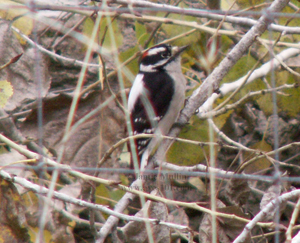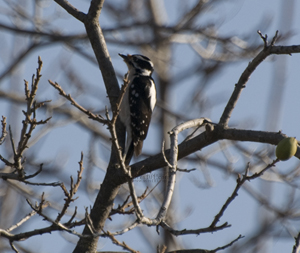Downy Woodpecker
Order: Piciformes
Family: Picidae
Genus: Picoides
Species: pubescens
**Audio Below**
Description
-
Length: 6.75"
-
Wing span: 12"
-
Weight: 0.95 oz (27 grams)
-
Small black and white woodpecker
-
Black-and-white barred with a large white oval convering most of the back
-
Black face with white eyebrow and cheek strap, small pointed bill
-
Throat, breast & belly white
-
Spots and streaks of black along sides and under tail and the outer tail feathers are white with black spots
-
Males and females look alike except that the male Nutall's has a red patch on the back of his head **Top photo is the Male and bottom photo is the female
-
Juvenile males resemble the adult Male but with a red crown instead of back of head, juvenile females resemble the adult female
Factoids:
- The smallest and most common American woodpecker, the Downy Woodpecker is found throughout most of North America from Alaska to Florida. It lives in a variety of habitats from wilderness forests to urban backyards, and comes readily to bird feeders
- The Downy Woodpecker is a frequent member of mixed species flocks in winter. The woodpecker is less vigilant looking for predators and more successful at foraging when in such a flock. It will readily join chickadees or other birds mobbing a predator, but it remains quiet and does not actually join in the mobbing
- Male and female Downy Woodpeckers may stay in the same areas in winter, but they divide up where they look for food. The male feeds more on small branches and weed stems, and the female feeds more on large branches and the trunks of trees. Males appear to keep the females from foraging in the more productive spots. When the male is removed from a woodlot, the female shifts her foraging to the smaller branches
- The Downy Woodpecker uses sources of food that larger woodpeckers cannot, such as the insect fauna of weed stems. It will cling to goldenrod galls to extract the gall fly larvae. The woodpecker prefers larger galls, and uses the exit tube constructed by the larva to extract it
- The Downy Woodpecker varies gradually across its range. Larger birds are found in the north and at higher elevations, while smaller birds live in the south and at lower elevations. Western woodpeckers tend to have less white in the wings and less black on the outer tail feathers
All photographs and audio clips are ©Jamie Mullin 2006
Sources: Cornell Lab of Ornithology & The Sibley Guide to Birds.
 |
|---|
 |